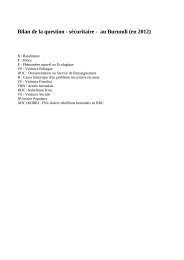Q3 Q4
g8iBkai
g8iBkai
Create successful ePaper yourself
Turn your PDF publications into a flip-book with our unique Google optimized e-Paper software.
fran ·· q2 2016<br />
tion. The non-cooperation of countries<br />
of origin remains a major problem and<br />
some Member States have developed<br />
strategies and operational measures to<br />
deal with the obstacles posed by certain<br />
countries of origin. Among the best practices<br />
shared by some Member States are<br />
task forces and cross-departmental cooperation<br />
frameworks, as well as practical<br />
initiatives with partner countries,<br />
such as the European Integrated Return<br />
Management Initiative (EURINT).<br />
Development of solutions to improve<br />
the return system requires time<br />
Another effective practice are identification<br />
missions, involving country of origin<br />
officials staying in Member States<br />
and issuing the necessary documentation<br />
to returnees of their own nationality<br />
on the spot. Again, in this context,<br />
the joining of forces between Member<br />
States when dealing with countries of<br />
origin is indispensable for encouraging<br />
them to readmit their nationals. For this<br />
reason, some Member States/Schengen<br />
Associated Countries are sharing identification<br />
missions.<br />
Towards an indicator forecasting<br />
return priorities<br />
A common element of all the mentioned<br />
solutions is that they demand a large<br />
amount of lead time for their planning<br />
and practical implementation. An early<br />
warning indicator forecasting upcoming<br />
return priorities would help to start the<br />
necessary preparatory work to deepen<br />
cooperation with countries of origin in<br />
due time and to improving the related<br />
operational infrastructure and regulatory<br />
framework. This indicator would need to<br />
take into account not only the number<br />
of migrants from a specific third country<br />
but also additional aspects, such as<br />
the overall rejection rate of asylum applications,<br />
rates of explicit and implicit<br />
withdrawals of asylum procedure, the<br />
number of return decisions and effective<br />
returns.<br />
21 of 37






